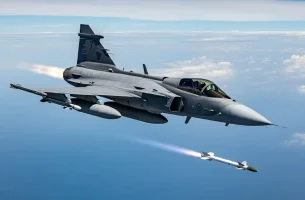- Views: 4K
- Replies: 34
Saab India has asserted that the Gripen-E fighter jet can effectively complement India's indigenous Tejas Mk2 within the Indian Air Force (IAF) fleet. This statement comes amidst the ongoing Multi-Role Fighter Aircraft (MRFA) tender for 110 jets, where Saab is positioning the Gripen-E as a strong contender.
While some defence analysts argue that acquiring the Gripen-E might lead to unnecessary duplication, Saab emphasizes the potential synergies between the two aircraft.
Both the Gripen-E and Tejas Mk2 belong to the same weight class, with the Gripen-E having a Maximum Take-Off Weight (MTOW) of 16.5 tons and the Tejas Mk2 slightly higher at 17.5 tons.
This similarity has fueled debate about the strategic necessity of procuring the Gripen-E when India is actively developing the Tejas Mk2, which offers marginally better range, endurance, and weapons-carrying capacity.
However, a Saab India official highlighted several advantages of having both aircraft in the IAF fleet. Firstly, both aircraft utilize the same F-414 engine, leading to significant benefits in logistics, maintenance, and training. This commonality could streamline operations, reduce costs, and simplify supply chain management for the IAF.
Secondly, the Gripen-E's modular software architecture allows for seamless integration with various weapons systems. This aligns with the Tejas Mk2's capabilities, ensuring both aircraft can operate with similar armaments and enhancing interoperability.
This compatibility would allow both types of jets to operate from the same airbase without requiring specialized infrastructure for each, offering a significant operational advantage.
Saab's argument focuses on strategic synergy rather than competition between the two platforms. By integrating the Gripen-E, India could leverage Saab's advanced combat systems technology and extensive combat experience, complementing the ongoing development of the Tejas Mk2. This approach could provide India with a diverse yet compatible fighter fleet capable of addressing various combat scenarios.
Despite these arguments, defence analysts remain divided. Some see potential benefits in technology transfer, immediate operational capability enhancement, and reduced logistical complexity.
Others argue that investing in the Gripen-E might not be the most cost-effective strategy when India is already committed to scaling up Tejas Mk2 production and development.
As the MRFA tender progresses, the debate over fleet composition will likely intensify. The decision will hinge on balancing indigenous capabilities, immediate combat readiness, and long-term strategic and financial investments.
Saab's proposal for the Gripen-E, emphasizing coexistence and synergy with the Tejas Mk2, offers a compelling case for how international partnerships can support national defence ambitions without undermining local development efforts.


